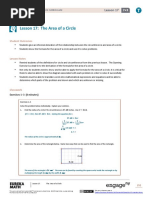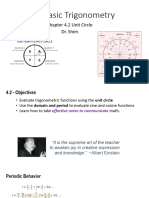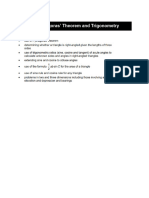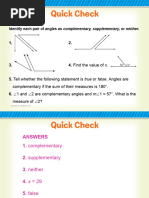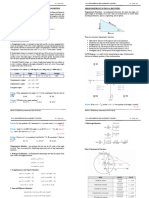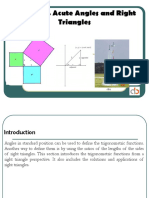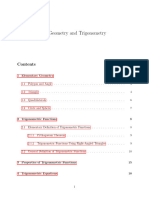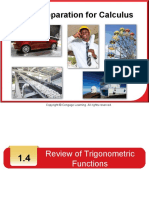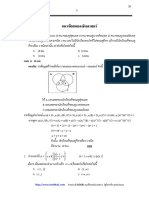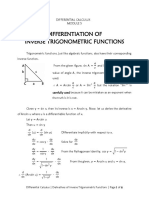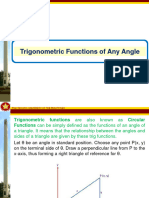Pcal 11 q2 1102 Final
Pcal 11 q2 1102 Final
Uploaded by
gianmikel delacruzCopyright:
Available Formats
Pcal 11 q2 1102 Final
Pcal 11 q2 1102 Final
Uploaded by
gianmikel delacruzCopyright
Available Formats
Share this document
Did you find this document useful?
Is this content inappropriate?
Copyright:
Available Formats
Pcal 11 q2 1102 Final
Pcal 11 q2 1102 Final
Uploaded by
gianmikel delacruzCopyright:
Available Formats
Unit 11: Circular Functions
Lesson 11.2
Solving Parts of a Triangle Using Circular Function
Relationships
Contents
Introduction 1
Learning Objectives 2
Warm Up 2
Learn about It! 3
Right Triangles 3
Trigonometric Ratios 3
Special Right Triangles 4
Other Triangles 12
Law of Sines 12
Law of Cosines 19
Key Points 25
Key Formulas 25
Check Your Understanding 27
Challenge Yourself 28
Bibliography 29
Key to Try It! 29
Unit 11: Circular Functions
Lesson 11.2
Solving Parts of a Triangle Using
Circular Function Relationships
Introduction
Surfing is one water activity that many Filipinos want to experience. The Philippines, being
an archipelago, has a lot of beaches. The best time and place to surf is affected by the
frequency and height of waves. Waves can be illustrated using sine and cosine functions.
This, among other interesting applications, makes circular functions a worthwhile topic.
In this lesson, we will discuss the relationship and some applications of circular functions to
triangles.
11.2. Solving Parts of a Triangle Using Circular Function Relationships 1
Unit 11: Circular Functions
Learning Objectives
DepEd Competencies
In this lesson, you should be able to do the
following: This lesson serves as an enrichment for
● Calculate the angles and sides of a right the following DepEd competencies:
• Illustrate the different circular
triangle using trigonometric ratios and the
functions
Pythagorean theorem.
(STEM_PC11T-llb-1).
● Solve for the missing measurements in a • Use reference angles to find exact
triangle using the sine law or the cosine values of circular functions.
(STEM_PC11T-llb-2).
law.
Warm Up
Angles and Sides 10 minutes
This activity will help you recall the Pythagorean theorem and an important rule about the
sum of the interior angles of any triangle.
Materials
● paper
● pen
Procedure
A. Let 𝑎, 𝑏, and 𝑐 be the sides of a right triangle, with 𝑐 as the hypotenuse. Find the
unknown side.
1. 𝑎 = 11, 𝑏 = 60, 𝑐 = ?
2. 𝑎 = 12, 𝑏 = 35, 𝑐 = ?
3. 𝑎 = 19, 𝑏 = 180, 𝑐 = ?
11.2. Solving Parts of a Triangle Using Circular Function Relationships 2
Unit 11: Circular Functions
B. Let 𝐴, 𝐵, and 𝐶 be the interior angles of a triangle. Find 𝑚∠𝐶 given 𝑚∠𝐴 and 𝑚∠𝐵.
1. 𝑚∠𝐴 = 18°, 𝑚∠𝐵 = 90°
2. 𝑚∠𝐴 = 104°, 𝑚∠𝐵 = 45°
3. 𝑚∠𝐴 = 101°, 𝑚∠𝐵 = 31°
Guide Questions
1. How were you able to solve for the missing side in Part A?
2. How were you able to solve for the missing angle in Part B?
3. How will you relate an interior angle of a triangle to its opposite side?
Learn about It!
In the previous lesson, circular functions were discussed in relation to the unit circle. In this
lesson, let us take a look at how circular functions are used in solving measures of sides of a
triangle.
How can we solve for the unknown side or angle of
a triangle using circular functions?
Right Triangles
Trigonometric Ratios
Consider a right triangle with an acute angle 𝜃, as illustrated below.
The circular functions sine, cosine, and tangent functions are used to represent trigonometric
ratios of the sides of a right triangle. The mnemonic SOH-CAH-TOA may be used.
11.2. Solving Parts of a Triangle Using Circular Function Relationships 3
Unit 11: Circular Functions
(𝐎)𝐩𝐩𝐨𝐬𝐢𝐭𝐞
𝑺𝑶𝑯 → (𝑺) 𝐬𝐢𝐧 𝜽 =
(𝐇)𝐲𝐩𝐨𝐭𝐞𝐧𝐮𝐬𝐞
(𝐀)𝐝𝐣𝐚𝐜𝐞𝐧𝐭
𝑪𝑨𝑯 → (𝑪) 𝐜𝐨𝐬 𝜽 =
(𝐇)𝐲𝐩𝐨𝐭𝐞𝐧𝐮𝐬𝐞
(𝐎)𝐩𝐩𝐨𝐬𝐢𝐭𝐞
𝑻𝑶𝑨 → (𝑻) 𝐭𝐚𝐧 𝜽 =
(𝐀)𝐝𝐣𝐚𝐜𝐞𝐧𝐭
From these, we can derive the ratios for cosecant, secant, and cotangent.
𝐡𝐲𝐩𝐨𝐭𝐞𝐧𝐮𝐬𝐞
𝐜𝐬𝐜 𝜽 =
𝐨𝐩𝐩𝐨𝐬𝐢𝐭𝐞
𝐡𝐲𝐩𝐨𝐭𝐞𝐧𝐮𝐬𝐞
𝐬𝐞𝐜 𝜽 =
𝐚𝐝𝐣𝐚𝐜𝐞𝐧𝐭
𝐚𝐝𝐣𝐚𝐜𝐞𝐧𝐭
𝐜𝐨𝐭 𝜽 =
𝐨𝐩𝐩𝐨𝐬𝐢𝐭𝐞
Regardless of the size of a right triangle, these trigonometric ratios remain the same.
Special Right Triangles
There are right triangles with ratios that can be calculated easily using the Pythagorean
theorem. Shown below are an isosceles right triangle and a 30°-60°-90° triangle.
Trigonometric ratios for angles in special triangles are listed in the following table.
11.2. Solving Parts of a Triangle Using Circular Function Relationships 4
Unit 11: Circular Functions
𝜽 𝐬𝐢𝐧 𝜽 𝐜𝐨𝐬 𝜽 𝐭𝐚𝐧 𝜽 𝐜𝐬𝐜 𝜽 𝐬𝐞𝐜 𝜽 𝐜𝐨𝐭 𝜽
1 √3 √3 2√3
30° 2 √3
2 2 3 3
45° √2 √2 1 1
√2 √2
2 2
√3 1 2√3 √3
60° √3 2
2 2 3 3
Let’s Practice!
Example 1
In the right triangle below, what is the measure of the hypotenuse?
Solution
Step 1: Identify the given values.
Let 𝑎 be the measure of the side adjacent to the 30°-angle.
𝜃 = 30°
𝑎=5
11.2. Solving Parts of a Triangle Using Circular Function Relationships 5
Unit 11: Circular Functions
Step 2: Identify the measure of the hypotenuse.
We use the cosine ratio to solve for the hypotenuse. We let 𝑐 represent the
hypotenuse of the right triangle.
adjacent
cos 𝜃 =
hypotenuse
5
cos 30° =
𝑐
√3 5
=
2 𝑐
5
𝑐=
√3
2
(5)(2)
𝑐=
√3
10√3
𝑐=
3
𝟏𝟎√𝟑
Therefore, the hypotenuse measures units.
𝟑
1 Try It!
In the right triangle in Example 1, solve for the measure of the side opposite 30° using
the sine ratio.
11.2. Solving Parts of a Triangle Using Circular Function Relationships 6
Unit 11: Circular Functions
Example 2
Find the measure of the side opposite the 45°-angle, given the right triangle below.
Solution
Step 1: Identify the given values.
Let 𝑎 be the measure of the side adjacent to the 45°-angle.
𝜃 = 45°
𝑎 = 10
Step 2: Identify the measure of the opposite side.
We use the tangent ratio to solve for the opposite side. Let 𝑏 be the measure of
the side opposite to the 45°-angle.
opposite
tan 𝜃 =
adjacent
𝑏
tan 45° =
10
𝑥
1=
10
𝑥 = 10
Therefore, the measure of the opposite side is 𝟏𝟎 units.
11.2. Solving Parts of a Triangle Using Circular Function Relationships 7
Unit 11: Circular Functions
2 Try It!
In the right triangle in Example 2, solve for the measure of the hypotenuse.
Example 3
Solve for the measures of sides 𝑎 and 𝑏, using the ratios for cosecant, secant, or cotangent.
Solution
Step 1: Identify the given values.
Let 𝑎 and 𝑏 be the measures of the legs of the triangle, and 𝑐 be the measure of
the hypotenuse.
𝜃 = 60°
𝑐 = 12
Step 2: Apply a trigonometric ratio to solve for 𝑎.
Based on the given values, we can use the formula for the secant ratio to solve
for 𝑎.
hypotenuse
sec 𝜃 =
adjacent
11.2. Solving Parts of a Triangle Using Circular Function Relationships 8
Unit 11: Circular Functions
12
sec 60° =
𝑎
12
2=
𝑎
12
𝑎=
2
𝑎=6
Step 3: Apply a trigonometric ratio to solve for 𝑏.
Based on the given values, we can use the formula for the cosecant ratio to
solve for 𝑏.
hypotenuse
csc 𝜃 =
opposite
12
csc 60° =
𝑏
2√3 12
=
3 𝑏
12
𝑏=
2√3
3
(12)(3)
𝑏=
2√3
𝑏 = 6√3
Therefore, side 𝑎 measures 𝟔 units long, and side 𝑏 measures 𝟔√𝟑 units long.
11.2. Solving Parts of a Triangle Using Circular Function Relationships 9
Unit 11: Circular Functions
3 Try It!
Solve for the measures of sides 𝑎 and 𝑏, using the ratios for sine, cosine, or tangent.
Example 4
A Narra tree casts a shadow that is 225 ft long. Find the height of the tree if the angle of
elevation of the sun from the tip of the shadow is 30°.
Solution
Step 1: Illustrate the given situation.
Let 𝑥 be the height of the tree.
11.2. Solving Parts of a Triangle Using Circular Function Relationships 10
Unit 11: Circular Functions
Step 2: Identify the given values.
In the given figure, the shadow represents the side adjacent to the 30°-angle,
and the height represents the side opposite to the 30°-angle.
𝜃 = 30°
adjacent side = 225 ft
opposite side = 𝑥
Step 3: Apply a trigonometric ratio to solve for the unknown.
Based on the given values, we can use the formula for the tangent ratio.
opposite
tan 𝜃 =
adjacent
𝑥
tan 30° =
225
√3 𝑥
=
3 225
(225)(√3)
𝑥=
3
𝑥 = 75√3
Therefore, the height of the tree is 𝟕𝟓√𝟑 feet.
4 Try It!
The height of a post is 40 ft. Find the length of the shadow if the angle of elevation of
the sun from the tip of the shadow is 45°.
11.2. Solving Parts of a Triangle Using Circular Function Relationships 11
Unit 11: Circular Functions
Other Triangles
Law of Sines
The Law of Sines (also called sine law) states that the angles of any triangle are proportional
to the length of the corresponding opposite side.
Consider the following triangle.
By the law of sines, we have the following proportion.
𝐬𝐢𝐧 𝑨 𝐬𝐢𝐧 𝑩 𝐬𝐢𝐧 𝑪
= =
𝒂 𝒃 𝒄
Example 5
Given the following triangle, solve for 𝑎.
11.2. Solving Parts of a Triangle Using Circular Function Relationships 12
Unit 11: Circular Functions
Solution
Step 1: Identify the given values.
𝑚∠𝐴 = 120°
𝑚∠𝐵 = 30°
𝑏 = 22
Step 2: Apply the law of sines.
sin 𝐴 sin 𝐵
=
𝑎 𝑏
sin 120° sin 30°
=
𝑎 22
The angle 120° is in the second quadrant, whose reference angle is 60°. Thus,
√3
sin 120° has the same value as sin 60°. Thus, sin 120° = .
2
√3 1
2 = 2
𝑎 22
1 √3
𝑎 = (22) ( )
2 2
√3
𝑎 = (2)(22) ( )
2
𝑎 = 22√3
Therefore, 𝒂 = 𝟐𝟐√𝟑 units.
5 Try It!
In the triangle in Example 5, solve for 𝑐.
11.2. Solving Parts of a Triangle Using Circular Function Relationships 13
Unit 11: Circular Functions
Example 6
Given the following triangle, find 𝑚∠𝐶.
Solution
Step 1: Identify the given values.
𝑚∠𝐴 = 135°
𝑎 = 16
𝑐 = 8√2
Step 2: Apply the law of sines.
sin 𝐴 sin 𝐶
=
𝑎 𝑐
sin 135° sin 𝐶
=
16 8√2
The angle 135° is in the second quadrant, whose reference angle is 45°. Thus,
√2
sin 135° has the same value as sin 45°. Thus, sin 135° = .
2
√2
2 = sin 𝐶
16 8 √2
√2
(8√2) 2
sin 𝐶 =
16
11.2. Solving Parts of a Triangle Using Circular Function Relationships 14
Unit 11: Circular Functions
1
sin 𝐶 =
2
Based on the figure, the angle 𝐶 is an acute angle. The acute angle in the first quadrant with
1
a sine value of 2 is 30°. Thus, 𝒎∠𝑪 = 𝟑𝟎°.
6 Try It!
Given the following triangle, find 𝑚∠𝐵.
Remember
The sum of the interior angles of any triangle is 180°.
Example 7
Solve for the measures of angle 𝐵 and side 𝑏.
11.2. Solving Parts of a Triangle Using Circular Function Relationships 15
Unit 11: Circular Functions
Solution
Step 1: Identify the given values.
𝑚∠𝐴 = 105°
𝑚∠𝐶 = 45°
𝑐 = 36
Step 2: Solve for 𝑚∠𝐵.
We can solve for 𝑚∠𝐵 since the sum of the interior angles in any triangle is 180°.
𝑚∠𝐵 = 180° − (𝑚∠𝐴 + 𝑚∠𝐶)
= 180° − (105° + 45°)
= 180° − 150°
= 30°
Step 3: Solve for side 𝑏 using sine law.
sin 𝐵 sin 𝐶
=
𝑏 𝑐
sin 30° sin 45°
=
𝑏 36
1 √2
2 = 2
𝑏 36
1
(2) (36)
𝑏=
√2
2
𝑏 = 18√2
Therefore, 𝒎∠𝑩 = 𝟑𝟎° and 𝒃 = 𝟏𝟖√𝟐 units.
11.2. Solving Parts of a Triangle Using Circular Function Relationships 16
Unit 11: Circular Functions
7 Try It!
Solve for the measures of angle 𝐶 and side 𝑐.
Example 8
Carlo is walking by a park and sees a beautiful yellow kite. The string of the kite is 66 meters
with an angle of 75° from its holder Nikko. How far away are the two kids from each other, if
Carlo is looking at the kite at a 60° angle?
Solution
Step 1: Illustrate the problem and identify the given values.
11.2. Solving Parts of a Triangle Using Circular Function Relationships 17
Unit 11: Circular Functions
𝑚∠𝐴 = 75°
𝑚∠𝐶 = 60°
𝑐 = 66 m
Step 2: Solve for 𝑚∠𝐵.
Remember that the sum of the interior angles of a triangle is 180°.
𝑚∠𝐵 = 180° − (𝑚∠𝐴 + 𝑚∠𝐶)
= 180° − (75° + 60°)
= 180° − 135°
= 45°
Step 3: Solve for 𝑏 using the law of sines.
sin 𝐵 sin 𝐶
=
𝑏 𝑐
sin 45° sin 60°
=
𝑏 66
√2 √3
2 = 2
𝑏 66
√2
(66) ( )
2
𝑏=
√3
2
𝑏 = 22√6
Thus, Carlo and Nikko are 𝟐𝟐√𝟔 meters away from each other.
11.2. Solving Parts of a Triangle Using Circular Function Relationships 18
Unit 11: Circular Functions
8 Try It!
A helicopter is hovering over two buildings, as illustrated below. Determine the
distance between the two buildings.
Law of Cosines
The Law of Cosines (also called cosine law) states a relationship between the sides and an
angle of a triangle.
Consider the following triangle.
11.2. Solving Parts of a Triangle Using Circular Function Relationships 19
Unit 11: Circular Functions
By the law of cosines, we have the following equations.
𝒂𝟐 = 𝒃𝟐 + 𝒄𝟐 − 𝟐𝒃𝒄 𝐜𝐨𝐬 𝑨
𝒃𝟐 = 𝒂𝟐 + 𝒄𝟐 − 𝟐𝒂𝒄 𝐜𝐨𝐬 𝑩
𝒄𝟐 = 𝒂𝟐 + 𝒃𝟐 − 𝟐𝒂𝒃 𝐜𝐨𝐬 𝑪
Example 9
Given the following triangle, solve for 𝑐.
Solution
Step 1: Identify the given values.
𝑚∠𝐶 = 60°
𝑎 = 18
𝑏 = 14
Step 2: Apply the law of cosines.
𝑐 2 = 𝑎 2 + 𝑏2 − 2𝑎𝑏 cos 𝐶
𝑐 2 = 182 + 142 − 2(18)(14)(cos 60°)
1
𝑐 2 = 324 + 196 − (504) ( )
2
𝑐 2 = 520 − 252
𝑐 2 = 268
𝑐 = 2√67
11.2. Solving Parts of a Triangle Using Circular Function Relationships 20
Unit 11: Circular Functions
Therefore, 𝒄 = 𝟐√𝟔𝟕 units.
9 Try It!
Given the following triangle, solve for 𝑏.
Example 10
Given the following triangle, solve for 𝑎.
Solution
Step 1: Identify the given values.
𝑚∠𝐴 = 150°
𝑏=3
𝑐=4
11.2. Solving Parts of a Triangle Using Circular Function Relationships 21
Unit 11: Circular Functions
Step 2: Apply the law of cosines.
𝑎 2 = 𝑏2 + 𝑐 2 − 2𝑎𝑏 cos 𝐴
𝑎 2 = 32 + 42 − 2(3)(4)[cos(150°)]
The angle 150° is an angle in the second quadrant whose reference angle is 30°.
Thus, cos 150° has the same value as cos 30°, but it will be negative since cosine
√3
is negative in the second quadrant. Thus, cos 150° = − 2
.
𝑎 2 = 9 + 16 + 12√3
𝑎 2 = 25 + 12√3
𝑎 = √25 + 12√3
Therefore, 𝒂 = √𝟐𝟓 + 𝟏𝟐√𝟑 units.
10 Try It!
Given the following triangle, solve for 𝑎.
11.2. Solving Parts of a Triangle Using Circular Function Relationships 22
Unit 11: Circular Functions
Example 11
A land surveyor would like to measure the length of a lake from his point of view. Solve for
the length of the lake using the measurements acquired by the land surveyor, as shown
below.
Solution
Step 1: Identify the given values.
𝑚∠𝐴 = 30°
𝑏 = 3.8 mi
𝑐 = 2.5 mi
Step 2: Solve for 𝑎 using the law of cosines.
𝑎 2 = 𝑏2 + 𝑐 2 − 2𝑏𝑐 cos 𝐴
𝑎 2 = 3.82 + 2.52 − 2(3.8)(2.5)(cos 30°)
√3
𝑎 2 = 14.44 + 6.25 − (19) ( )
2
19√3
𝑎 2 = 20.69 −
2
19√3
𝑎 = √20.69 −
3
11.2. Solving Parts of a Triangle Using Circular Function Relationships 23
Unit 11: Circular Functions
Thus, the lake is approximately 2.06 miles long.
11 Try It!
Arya went on an island-hopping on three islands, as illustrated below. How far is
Island C from Island A?
When can we use the law of cosines?
11.2. Solving Parts of a Triangle Using Circular Function Relationships 24
Unit 11: Circular Functions
Key Points
___________________________________________________________________________________________
● In solving for the measures of the sides of a triangle, we can use the trigonometric
ratios, the Pythagorean theorem, the special right triangle theorems, and the
Laws of Sines and Cosines.
● The Law of Sines states that the angles of any triangle are proportional to the length
of the corresponding opposite side.
● The Law of Cosines states a relationship between the sides and an angle of a triangle.
___________________________________________________________________________________________
Key Formulas
___________________________________________________________________________________________
Concept Formula Description
Pythagorean 𝑐 2 = 𝑎2 + 𝑏2 Use the Pythagorean
Theorem theorem when solving for a
where 𝑎 and 𝑏 are the legs, and 𝑐 side of a right triangle, given
is the hypotenuse. the other two sides.
Trigonometric opposite Use these trigonometric
sin 𝜃 =
Ratios hypotenuse ratios when solving for an
unknown side or angle of a
adjacent
cos 𝜃 = triangle.
hypotenuse
opposite
tan 𝜃 =
adjacent
hypotenuse
csc 𝜃 =
opposite
hypotenuse
sec 𝜃 =
adjacent
11.2. Solving Parts of a Triangle Using Circular Function Relationships 25
Unit 11: Circular Functions
adjacent
cot 𝜃 =
opposite
Law of Sines sin 𝐴 sin 𝐵 sin 𝐶 Use this formula when an
= =
𝑎 𝑏 𝑐 angle and its corresponding
side is given with another
angle or side.
Law of Cosines 𝑎 2 = 𝑏2 + 𝑐 2 − 2𝑏𝑐 cos 𝐴 Use this formula when three
sides or two sides and an
𝑏2 = 𝑎 2 + 𝑐 2 − 2𝑎𝑐 cos 𝐵 included angle are given.
𝑐 2 = 𝑎 2 + 𝑏2 − 2𝑎𝑏 cos 𝐶
___________________________________________________________________________________________
11.2. Solving Parts of a Triangle Using Circular Function Relationships 26
Unit 11: Circular Functions
Check Your Understanding
A. Find the six trigonometric ratios with respect to angle 𝜃 in the
given figure.
1. sin 𝜃
2. cos 𝜃
3. tan 𝜃
4. csc 𝜃
5. sec 𝜃
6. cot 𝜃
B. Solve the indicated sides and angles in the triangle below.
1. 𝑚∠𝐶𝐴𝐵
2. 𝐴𝐵
3. 𝐴𝐶
4. 𝐵𝐶
11.2. Solving Parts of a Triangle Using Circular Function Relationships 27
Unit 11: Circular Functions
C. Sketch a triangle with 𝑚∠𝐴 = 30°, 𝑚∠𝐵 = 120°, and side 𝑐 = 50
units, which is opposite to angle 𝐶. Solve for the measure of the
other parts of the triangle as well.
D. Sketch a triangle with side 𝑎 = 60 units, which is opposite to angle
𝐴, and angles 𝐵 and 𝐶 where 𝑚∠𝐵 = 30° and 𝑚∠𝐶 = 60°. Solve for
the measure of the other parts of the triangle as well.
Challenge Yourself
Answer the following questions.
1. Why are the trigonometric ratios not affected by the size of the right triangle?
2. Camille and Alice went home from Carl’s house. Camille walked 8 meters north, while
Alice walked a few blocks east of Carl’s house. If the included angle at Camille’s house
is 60°, how far is Alice’s house from Camille’s house?
3. Stations A and B received a call about a crime located at 45° northeast of station A.
Station B is 13 miles away from the crime, which is 60° northwest from it. Will the police
from station B arrive ahead of the police from station A, assuming that they responded
to the call and go to the crime scene at the same speed? Explain your answer.
4. A triangular lot has sides of lengths 25 m, 32 m, and 44 m. What is the measure of its
largest angle?
5. A parallelogram has sides three units and six units long, and an interior angle that
measures 60°. What are the lengths of its diagonals?
11.2. Solving Parts of a Triangle Using Circular Function Relationships 28
Unit 11: Circular Functions
Bibliography
Edwards, C.H., and David E. Penney. Calculus: Early Transcendentals. 7th ed. Upper Saddle
River, New Jersey: Pearson/Prentice Hall, 2008.
Larson, Ron H., and Bruce H. Edwards. Essential Calculus: Early Transcendental Functions.
Boston: Houghton Mifflin, 2008.
Leithold, Louis. The Calculus 7. New York: HarperCollins College Publ., 1997.
Smith, Robert T., and Roland B. Milton. Calculus. New York: McGraw Hill, 2012.
Tan, Soo T. Applied Calculus for the Managerial, Life, and Social Sciences: A Brief Approach.
Australia: Brooks/Cole Cengage Learning, 2012.
Key to Try It!
5√3
1. 3
2. 10√2
25 25√3
3. 𝑎 = 2
;𝑏 = 2
4. 40 ft
5. 22 units
6. 𝑚∠𝐵 = 45°
15√6
7. 𝐶 = 120° ; 𝑐 = 2
8. 50√6 meters
9. √149 − 70√2 or approximately 7.07
10. √202 + 99√3 or approximately 19.33
11. 20√19 miles
11.2. Solving Parts of a Triangle Using Circular Function Relationships 29
You might also like
- Complete Algebra Calculus Laplace Cheat SheetDocument14 pagesComplete Algebra Calculus Laplace Cheat SheetJeremy100% (3)
- Short Tricks of Maths For Iit-JeeDocument38 pagesShort Tricks of Maths For Iit-JeePraveen Kaushik73% (51)
- SLM 4 Trigonometric Ratios of Special Angles 22 23Document10 pagesSLM 4 Trigonometric Ratios of Special Angles 22 23Kate Megan ApuliNo ratings yet
- 2312 - Section 4.1 Special Triangles and Trigonometric RatiosDocument8 pages2312 - Section 4.1 Special Triangles and Trigonometric RatiosKeiah A. QuiliopeNo ratings yet
- Review Module 1Document5 pagesReview Module 1aljohnbondad121521No ratings yet
- Trigonometric FunctionsDocument10 pagesTrigonometric Functionsmaranoangela020No ratings yet
- Module 3 - Lesson 2 - Circular FunctionsDocument40 pagesModule 3 - Lesson 2 - Circular FunctionsGavriel Tristan Vital100% (2)
- Pre-Calculus For non-STEM (Algebra & TrigonometryDocument18 pagesPre-Calculus For non-STEM (Algebra & TrigonometryAlfeo DucejoNo ratings yet
- 28 Mod 6Document14 pages28 Mod 6Rogie BalawonNo ratings yet
- Trigonometry 1 17Document17 pagesTrigonometry 1 17Md Munna IslamNo ratings yet
- Q4 W4 Solving Right TrianglesDocument41 pagesQ4 W4 Solving Right TrianglesAkysha sheenNo ratings yet
- 312 Using Trigonometry Finding The Missing AngleDocument24 pages312 Using Trigonometry Finding The Missing Angleleenmsamy.1No ratings yet
- Wk2 q2 Circular Functions NewwDocument51 pagesWk2 q2 Circular Functions NewwJHANRICK BINUNGCALNo ratings yet
- Math 1Document39 pagesMath 1bekobaka2No ratings yet
- Math g7 m3 Topic C Lesson 17 TeacherDocument10 pagesMath g7 m3 Topic C Lesson 17 TeacherAngelina Uruchima-CabreraNo ratings yet
- Plate TrigonometryDocument39 pagesPlate Trigonometrysibbaluca.marian30No ratings yet
- Experiment 4 Conical PendulumDocument9 pagesExperiment 4 Conical PendulumKassy MondidoNo ratings yet
- PRECALCULUS-Q2-TRIGONOMETRY-LESSON8-CIRCULAR-FUNCTIONSDocument13 pagesPRECALCULUS-Q2-TRIGONOMETRY-LESSON8-CIRCULAR-FUNCTIONScaithressllanoNo ratings yet
- Lesson 4-8 Stem 1BDocument15 pagesLesson 4-8 Stem 1BJune Patricia AraizNo ratings yet
- UKMT IntermediteDocument25 pagesUKMT Intermediteiamforger448No ratings yet
- Physics: Physical ConstantsDocument8 pagesPhysics: Physical ConstantsJjxjcjNo ratings yet
- Lecture Notes 4.2 - Unit Circle (F2023)Document11 pagesLecture Notes 4.2 - Unit Circle (F2023)samuelxs238No ratings yet
- Edited G9mathq4m2Document14 pagesEdited G9mathq4m2a.hannacomighud2008No ratings yet
- Pythagoras' Theorem and TrigonometryDocument17 pagesPythagoras' Theorem and TrigonometrykhanatipchokoonkitNo ratings yet
- STEM1 Lesson 2 - Circular Functions FlemingDocument44 pagesSTEM1 Lesson 2 - Circular Functions FlemingSean Andrei MntñrNo ratings yet
- Trigonometric Functions of Acute Angles: Right Triangle TrigonometryDocument9 pagesTrigonometric Functions of Acute Angles: Right Triangle TrigonometrynathanNo ratings yet
- Bridge Course Mathematics 2022-23 - IxDocument21 pagesBridge Course Mathematics 2022-23 - IxManish RathoreNo ratings yet
- 6.2 Intro To Plane TrigonometryDocument2 pages6.2 Intro To Plane Trigonometrydavemortel124No ratings yet
- IB DP Mathematics AA Topic 3 SyllabusDocument3 pagesIB DP Mathematics AA Topic 3 SyllabusTaehyeon KimNo ratings yet
- Investigatory Project Trigonometric Functions 3Document9 pagesInvestigatory Project Trigonometric Functions 3pqsfj7vfc5No ratings yet
- Trig.sydneyDocument40 pagesTrig.sydneyExcellent DamsNo ratings yet
- EnggMath1 Module 2 - Trigonometry Slides Draft As of 08312020Document68 pagesEnggMath1 Module 2 - Trigonometry Slides Draft As of 08312020Aereal MariNo ratings yet
- Chapter 7 Lesson 3 Presentation Course 2Document18 pagesChapter 7 Lesson 3 Presentation Course 2Sally SamirNo ratings yet
- Detailedlessonplanintrigonometry 130303203030 Phpapp01Document4 pagesDetailedlessonplanintrigonometry 130303203030 Phpapp01george taclobaoNo ratings yet
- Reviewer in Pre-Calculus 11Document18 pagesReviewer in Pre-Calculus 11RJ Seva IIINo ratings yet
- Chapter 0 Introduction to Math-based PhysicsDocument43 pagesChapter 0 Introduction to Math-based PhysicsRORONo ratings yet
- A Detailed Lesson Plan in Math IVDocument5 pagesA Detailed Lesson Plan in Math IVBrenda OpawNo ratings yet
- Geec 107 - Module IiDocument30 pagesGeec 107 - Module IiMarooning ManNo ratings yet
- Law of SinesDocument6 pagesLaw of SinesEunice PendejitoNo ratings yet
- m118 Reflective TeachingDocument6 pagesm118 Reflective Teachingiana.butalidNo ratings yet
- Quarter 4 - Lesson 1 - The Six Trigonometric RatioDocument32 pagesQuarter 4 - Lesson 1 - The Six Trigonometric RatioLeah Mae OrtizNo ratings yet
- Plane and Solid Mensuration Lesson 6Document11 pagesPlane and Solid Mensuration Lesson 6Mark Johnson Dela PeñaNo ratings yet
- Q4 STEM Pre Caculus Week1Document4 pagesQ4 STEM Pre Caculus Week1Ykhay ElfanteNo ratings yet
- Ec 1 - Module 3 - Plane and Spherical TrigonometryDocument6 pagesEc 1 - Module 3 - Plane and Spherical TrigonometryJhenzel AlferezNo ratings yet
- Screenshot 2024-01-28 at 6.52.19 PMDocument57 pagesScreenshot 2024-01-28 at 6.52.19 PMmartinjrmwewaNo ratings yet
- Introduction to Trigonometry in Class 10 CBSEDocument8 pagesIntroduction to Trigonometry in Class 10 CBSEtavneetsinghrajpal13No ratings yet
- Client BriefDocument7 pagesClient Briefkellymax25No ratings yet
- Notes 4.4-The Unit CircleDocument5 pagesNotes 4.4-The Unit CircleyolovekuruyuzuNo ratings yet
- Week 29 Maths (Lead) - TrigonometryDocument20 pagesWeek 29 Maths (Lead) - Trigonometryeshaal junaidNo ratings yet
- Math9 Q4 W8Document6 pagesMath9 Q4 W8Maria Eleonor BanaresNo ratings yet
- Trigonometry WorkbookDocument20 pagesTrigonometry WorkbookElaine zhuNo ratings yet
- Precalculus Week3 4 2ND QDocument29 pagesPrecalculus Week3 4 2ND QnathanalocilloNo ratings yet
- Lesson 2 - Acute Angle & Right TriangleDocument60 pagesLesson 2 - Acute Angle & Right TriangleSharmaine TuliaoNo ratings yet
- Math9 Q4 W1-W8-52pagesDocument52 pagesMath9 Q4 W1-W8-52pagesRaien RiveraNo ratings yet
- EM1 Ex5theoryDocument29 pagesEM1 Ex5theoryBùi Thái HoàngNo ratings yet
- Circular Functions and TrigonometryDocument6 pagesCircular Functions and TrigonometryLorraine SabbaghNo ratings yet
- Directions: Consider The Table Below. Given Each Figure, Recall The Definition of Each Quadrilateral and Write It On The Space ProvidedDocument19 pagesDirections: Consider The Table Below. Given Each Figure, Recall The Definition of Each Quadrilateral and Write It On The Space ProvidedJaninne Villa Del ReyNo ratings yet
- LarCalcETF7e 01 04calculusDocument45 pagesLarCalcETF7e 01 04calculusDerviş Hasan SubaşıNo ratings yet
- Functions and Graphs 2: Trigonometric FunctionDocument20 pagesFunctions and Graphs 2: Trigonometric FunctionMalik MalikNo ratings yet
- Arc Lenght and Area of The SectorDocument19 pagesArc Lenght and Area of The Sectormaranoangela020No ratings yet
- MathsTraks: Geometry: A Collection of Blackline Masters for ages 11-14From EverandMathsTraks: Geometry: A Collection of Blackline Masters for ages 11-14No ratings yet
- IntegralDocument5 pagesIntegralRoselyn MatienzoNo ratings yet
- TrigonomertyDocument5 pagesTrigonomerty9876akshayNo ratings yet
- Mathematics Trigonometry MCQ PDFDocument13 pagesMathematics Trigonometry MCQ PDFhema iyer43% (7)
- Trigonometric Identities and FormulasDocument5 pagesTrigonometric Identities and FormulasRupesh VermaNo ratings yet
- 7.4 The Polar Form: B Z A + BJ (A, B) RDocument2 pages7.4 The Polar Form: B Z A + BJ (A, B) RprevrtljivacNo ratings yet
- MCR3U Unit 4 Practice TestDocument7 pagesMCR3U Unit 4 Practice TestSugarPlayzNo ratings yet
- GeometryDocument233 pagesGeometryMuhammad Adnan LaghariNo ratings yet
- คณิตศาสตร์Document34 pagesคณิตศาสตร์Atcharaporn UparaNo ratings yet
- Answer Model Paper PDFDocument10 pagesAnswer Model Paper PDFSuelly SabriNo ratings yet
- How To Learn Trigonometry Intuitively - BetterExplainedDocument48 pagesHow To Learn Trigonometry Intuitively - BetterExplainedZach Ferger100% (1)
- Maths Theory ErrorlessDocument192 pagesMaths Theory ErrorlessabcNo ratings yet
- Properties of Exponents and LogarithmsDocument2 pagesProperties of Exponents and LogarithmsRAVI ANANTHAKRISHNANNo ratings yet
- Trigonometric Equation: Om SharmaDocument12 pagesTrigonometric Equation: Om SharmaaryanNo ratings yet
- Complex Variables Lecture NotesDocument11 pagesComplex Variables Lecture NotesShan_ShripadNo ratings yet
- Trigonometry For Class 10: By-Sudhanshu Sabharwal B.Tech (Civil Engineering) 2015Document26 pagesTrigonometry For Class 10: By-Sudhanshu Sabharwal B.Tech (Civil Engineering) 2015Santosh Kr AidniNo ratings yet
- Module 5 - Derivatives of Inv Trig FunctionsDocument6 pagesModule 5 - Derivatives of Inv Trig FunctionsMaria Andres100% (1)
- Laplace Table PDFDocument2 pagesLaplace Table PDFSiao DaNo ratings yet
- C3 May 2006 Mark Scheme PDFDocument7 pagesC3 May 2006 Mark Scheme PDFAhmed AmanNo ratings yet
- Catatan Matematika - TrigonometriDocument1 pageCatatan Matematika - Trigonometri33 SHARA FEBRIANA ANGGRAINI100% (1)
- SEMA 103-Lesson 4Document36 pagesSEMA 103-Lesson 4Atasha Fei DioquinoNo ratings yet
- Math 2nd QuarterDocument24 pagesMath 2nd QuarterDea Alyza GasparNo ratings yet
- Exponents Laws Print ActDocument8 pagesExponents Laws Print Actmarife galecioNo ratings yet
- C2 Trigonometry - Sine and Cosine RuleDocument15 pagesC2 Trigonometry - Sine and Cosine RuleCHAN CHLOENo ratings yet
- Weekly Eoc Concepts and GroupsDocument2 pagesWeekly Eoc Concepts and Groupsapi-313623093No ratings yet
- Trigonometry AA HLDocument30 pagesTrigonometry AA HLcufrinkeaphhqujjxeNo ratings yet
- Practice Differentiation Math 120 Calculus IDocument6 pagesPractice Differentiation Math 120 Calculus IRajpal SinghNo ratings yet
- Logarithmic DifferentiationDocument6 pagesLogarithmic DifferentiationjeffconnorsNo ratings yet
- M22 Extended Mathematics (English) MarkschemeDocument41 pagesM22 Extended Mathematics (English) MarkschemeNaman VasdevNo ratings yet














